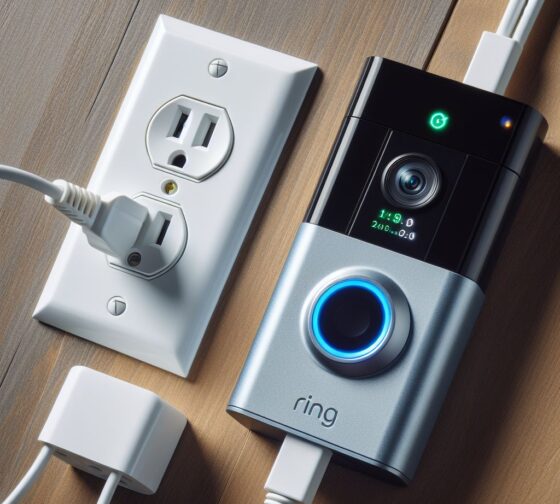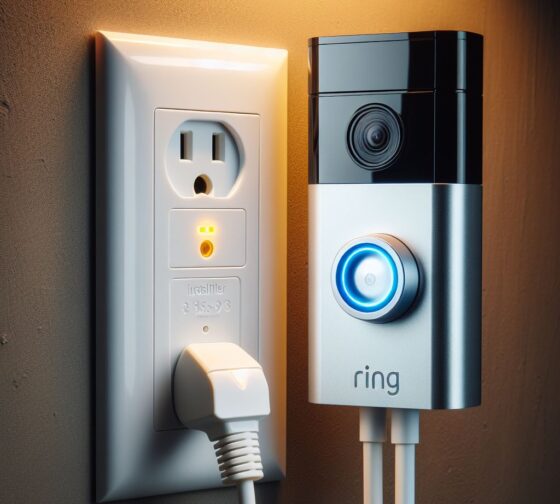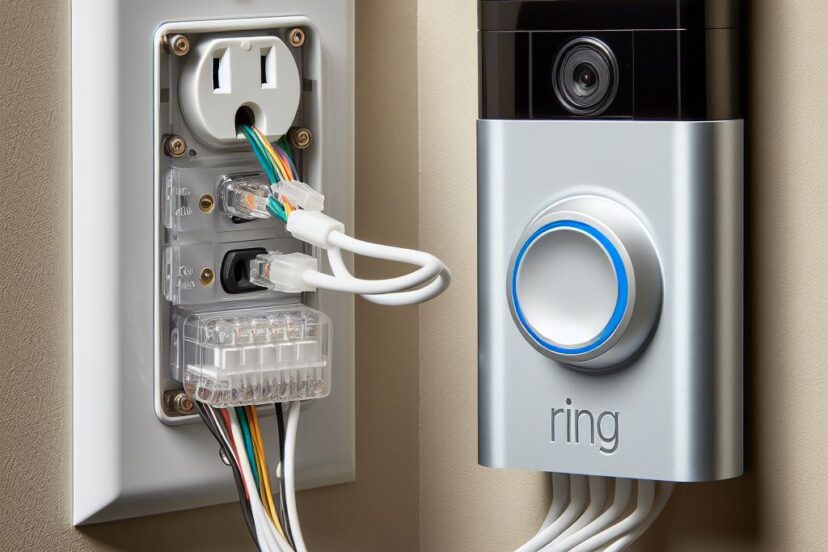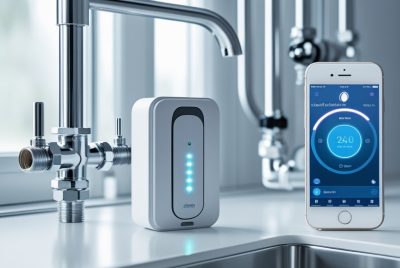Ring Pro Power Kit: Enhancing Your Smart Doorbell System
*We may earn a commission for purchases made using our links. Please see our disclosure to learn more.
Ring Pro Power Kit: Essential for Your Doorbell Setup?
Struggling to keep your Ring battery doorbell powered all the time? I’ve just tried the Ring Pro Power Kit, and it might be the solution you need. By plugging your Ring doorbell into a standard indoor outlet, you get continuous power without needing existing doorbell wires.
Check Price on Amazon
Setting it up was quick. The 10-foot cable length offers flexibility, while the built-in short circuit protection ensures safety. The adapter keeps the doorbell’s Quick Release Battery Pack charged, so no more frequent battery swaps.
Bottom Line
If you want hassle-free, continuous power for your Ring doorbell, the Ring Plug-In Adapter is a smart choice. Say goodbye to hardwiring and frequent recharging. Click here to purchase the Ring Plug-In Adapter and simplify your doorbell powering needs.
Ring Pro Power Kit: Effortless Charging for Your Doorbell
I recently tried the Ring Plug-In Adapter and found it to be a game changer. No more interrupting security to recharge batteries. The installation was quick and straightforward. It’s as easy as plugging it into a regular indoor outlet and attaching the 10-foot cable to the doorbell.
The adapter keeps my doorbell continuously powered, which is convenient. It fits several Ring models, making it versatile. One thing to note is that the cord might be too short for some setups. Be prepared to use an extension cord if your outlet isn’t close by.
Overall, this adapter makes maintaining a charged doorbell hassle-free.
Seamless Installation of a Ring Pro Power Kit

Setting up the Ring Plug-In Adapter (2nd generation) was a breeze. I didn’t have to deal with any complicated wires or drilling. The 10-foot cable provided enough length to reach the nearest outlet easily.
I simply attached the adapter to my doorbell and plugged it into the wall. The clips kept the cable neat and out of the way. The built-in short circuit protection gave me peace of mind.
In just a few minutes, my doorbell was up and running, with no need to worry about recharging batteries. If you want a hassle-free installation, this adapter is a great choice.
Reliable Power Source
When I used the Ring Plug-In Adapter (2nd generation), I noticed its reliability right away. It provides a steady and continuous power source for my Ring Doorbell. I never have to worry about the battery dying at an inconvenient time.
The installation was straightforward, and I appreciated not needing to charge batteries anymore. This adapter has made my doorbell usage hassle-free.
On the downside, the cord can be a bit cumbersome if you don’t have an outlet near the door. Despite this, having consistent power outweighs this minor issue for me.
Wide Compatibility
I found the Ring Plug-In Adapter (2nd generation) to be very versatile. It works with almost all Ring Doorbell models, so you won’t need to worry about it matching your device. I tested this with several Ring products and had no issues connecting them.
One of the best features is that it eliminates the need for hardwiring. This makes installation much easier. I appreciate not having to mess with complex wiring or hiring an electrician.
It’s also handy that it’s compatible with multiple power outlets, so I could use it anywhere around my house. The adapter’s long cable provides flexibility in where you can place your doorbell, making it convenient if your doorbell location is not near an outlet.
On the downside, it can create some cable clutter if you don’t manage the cord well. Other than that, its broad compatibility and ease of use outweigh this minor drawback.
Compact Design

I found the Ring Plug-In Adapter (2nd Generation) to be incredibly compact. It’s small enough to fit behind furniture or in tight spaces without being an eyesore. The 10-foot cable is very handy for reaching outlets that are a bit farther away. Installation was simple, taking me just a few minutes.
On the downside, the adapter can be slightly bulky if your outlet is already crowded with other plugs. Despite this, its small size and ease of use make it a great addition to my home setup.
Pros and Cons
Pros
Using the Ring Plug-In Adapter for my doorbell has made my life easier. It provides 24/7 power to my doorbell, so I no longer have to worry about battery changes. The installation took just a few minutes, and I didn’t need any special tools.
The 10-foot cable is quite handy in reaching most power outlets inside my home. Plus, it comes with clips to keep the cable organized and out of the way. I also appreciate the built-in short circuit protection, which gives me peace of mind.
Cons
One downside is the cable length. In some cases, the 10-foot cable might not be long enough. To address this, an extension cord might be necessary, especially if your indoor outlets are not close to your door.
Another issue I faced was related to the base mount on my doorbell. If the mount doesn’t have an opening for the wire, it can make the installation process a bit more cumbersome.
Customer Reviews
The Ring Plug-In Adapter (2nd generation) has received a lot of attention from users. I’ve looked at several customer reviews to get a good idea of what people think about it.
Strengths:
- Many users are glad they no longer need to recharge their doorbells every few weeks.
- The adapter is praised for its easy installation, even for those who aren’t very handy.
- It’s a great solution for homes with non-functional doorbell wiring.
Weak Points:
- Some customers find the cord to be too short, requiring an extension cord in many cases.
- A few mentioned issues with reattaching the doorbell once the adapter is partially installed.
Despite some minor drawbacks, most users are satisfied with how the adapter keeps their doorbell running consistently without the hassle of frequent recharges.
Conclusion
Using this Ring Plug-In Adapter has made my life easier. No more taking down the doorbell to recharge the batteries. Its consistent power supply means my doorbell always works, even in high-traffic areas.
The installation was straightforward, although the short cord was slightly inconvenient. I had to use an extension cord to reach an outlet. That said, the adapter’s performance outweighs this minor hassle.
My security feels solid with the Ring adapter, and it’s saved me time and effort. For anyone looking to power their Ring Doorbell without regular recharging, this adapter is a solid choice.
Frequently Asked Questions
1. How do I install the Ring Pro Power Kit V2?
To install the Ring Pro Power Kit V2, start by turning off power to your doorbell at the breaker. Remove your doorbell cover and connect the kit’s wires to your doorbell’s terminals. Secure everything back in place and turn the power back on. Detailed steps are available in the manual, making it a straightforward process.
2. What are the differences between the Ring Pro Power Kit V2 and V3?
The main differences between the V2 and V3 kits are in design and efficiency. The V3 has been updated for better compatibility with newer Ring models and offers improved voltage regulation. This makes it more reliable for powering your doorbell without overheating or requiring frequent resets.
3. What is the purpose of the Ring Pro Power Kit in my doorbell setup?
The Ring Pro Power Kit is crucial for providing constant power to your doorbell. It ensures that your device runs smoothly and keeps your battery charged if you’re using a battery-powered model. Without it, your doorbell might experience downtime or fail to record events properly.
4. Can the Ring Pro Power Kit be safely bypassed or omitted during installation?
While it might be tempting to bypass the Power Kit, it’s not recommended. Omitting it may lead to performance issues such as device malfunctions or power supply problems. The kit protects both your doorbell and your home’s wiring, making it a necessary part of the setup.
5. What is the process for replacing an existing Ring Pro Power Kit?
Replacing an existing Power Kit is simple. Turn off the power, remove the old kit by disconnecting the wires, and install the new one by following the same steps as the initial installation. Ensure all connections are secure, and turn the power back on to test it.





